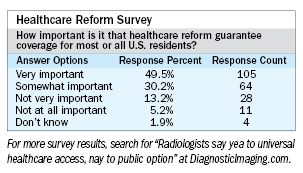Radiologists back universal coverage, pan 'public option'
In an online survey conducted by Diagnostic Imaging, members of the diagnostic radiology community expressed strong support for the idea that healthcare reform should guarantee access to care for most or all U.S. residents.
In an online survey conducted by Diagnostic Imaging, members of the diagnostic radiology community expressed strong support for the idea that healthcare reform should guarantee access to care for most or all U.S. residents. But they were also strongly opposed to the idea of a government-run alternative to private insurance, a strategy still under consideration as a way to achieve wider coverage.
A majority said they would agree to follow national practice guidelines in return for a cap on malpractice judgments, agreed that limits on self-referred imaging would reduce imaging costs, and strongly agreed that healthcare costs can be significantly reduced by eliminating inefficient, redundant, or wasteful practices.
The survey was conducted in mid-August in the midst of contentious town hall meetings across the country about healthcare reform and before legislative measures were debated on U.S. Senate and House floors. It drew 220 respondents.

In some respects, the survey suggests that the diagnostic imaging community is primed for some of the changes that could take place if healthcare reform measures survive a battle in Congress and are signed into law by President Obama.
A solid majority either strongly agreed or somewhat agreed that inappropriate imaging practices could be reduced through some form of prior authorization. And nearly 70% agreed that medical imaging has been targeted for reform-related cost reductions.
Survey respondents were not optimistic about what healthcare reform could mean for them personally or for the development of the specialty. Slightly more than 64% said that research and development innovations for new medical imaging technologies and applications would somewhat or substantially decrease under healthcare reform.
Nearly 70% said they anticipated that radiologist income in the next five years would decrease somewhat or substantially under healthcare reform. They were nearly evenly split on what healthcare reform could mean for demand
for imaging services: 32% anticipated it would increase substantially or somewhat; 40% anticipated it would decrease substantially or somewhat, and 24% were undecided.
Respondents were also asked how satisfied they were with their practice as radiologists. Of 179 who answered that question, 30.7% were very satisfied, 32.4% were somewhat satisfied, 25.7% were neither satisfied nor dissatisfied, 8.9% were somewhat dissatisfied, and 2.2% were very dissatisfied.
GE HealthCare Debuts AI-Powered Cardiac CT Device at ACC Conference
April 1st 2025Featuring enhanced low-dose image quality with motion-free images, the Revolution Vibe CT system reportedly facilitates improved diagnostic clarity for patients with conditions ranging from in-stent restenosis to atrial fibrillation.
The Reading Room Podcast: Current Perspectives on the Updated Appropriate Use Criteria for Brain PET
March 18th 2025In a new podcast, Satoshi Minoshima, M.D., Ph.D., and James Williams, Ph.D., share their insights on the recently updated appropriate use criteria for amyloid PET and tau PET in patients with mild cognitive impairment.